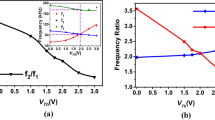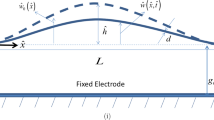Abstract
We investigate, experimentally and theoretically, the linear mode coupling between the first symmetric and antisymmetric modes of an electrothermally tuned and electrostatically actuated micromachined arch resonator. The arch is excited using an antisymmetric partial electrode to activate both modes of vibrations. Theoretically, we explore the static and dynamic behavior using the Galerkin method. When tuning the electrothermal voltage, the first symmetric frequency increases while the first antisymmetric frequency decreases until they cross. The results show linear coupling and hybridization of both modes near crossing only in the presence of the perturbation from the electrostatic force using the partial electrode. We show the linear merging of both modes at crossing. Also, the eigenfrequency variation around crossing shows a ratio of 2:1 between the second symmetric mode and the first symmetric/antisymmetric modes, which can lead to simultaneous 1:1 and 2:1 internal resonances.







Similar content being viewed by others
References
Potekin, R., Dharmasena, S., Keum, H., Jiang, X., Lee, J., Kim, S., Bergman, L.A., Vakakis, A.F., Cho, H.: Multi-frequency atomic force microscopy based on enhanced internal resonance of an inner-paddled cantilever. Sens. Actuators A Phys. 273, 206–220 (2018)
Zhang, T., Wei, X., Jiang, Z., Cui, T.: Sensitivity enhancement of a resonant mass sensor based on internal resonance. Appl. Phys. Lett. 113(22), 223505 (2018)
Hajjaj, A.Z., Hafiz, M.A., Younis, M.I.: Mode coupling and nonlinear resonances of MEMS arch resonators for bandpass filters. Sci. Rep. 7, 41820 (2017)
Antonio, D., Zanette, D.H., López, D.: Frequency stabilization in nonlinear micromechanical oscillators. Nat. Commun. 3, 806 (2012)
Charmet, J., Daly, R., Thiruvenkatanathan, P., Woodhouse, J., Seshia, A.A.: Observations of modal interaction in lateral bulk acoustic resonators. Appl. Phys. Lett. 105(1), 013502 (2014)
Pu, D., Wei, X., Xu, L., Jiang, Z., Huan, R.: Synchronization of electrically coupled micromechanical oscillators with a frequency ratio of 3:1. Appl. Phys. Lett. 112(1), 013503 (2018)
Karabalin, R., Cross, M., Roukes, M.: Nonlinear dynamics and chaos in two coupled nanomechanical resonators. Phys. Rev. B 79(16), 165309 (2009)
Mahboob, I., Dupuy, R., Nishiguchi, K., Fujiwara, A., Yamaguchi, H.: Hopf and period-doubling bifurcations in an electromechanical resonator. Appl. Phys. Lett. 109(7), 073101 (2016)
Daqaq, M.F., Abdel-Rahman, E.M., Nayfeh, A.H.: Two-to-one internal resonance in microscanners. Nonlinear Dyn. 57(1–2), 231 (2009)
Hajjaj, A., Jaber, N., Hafiz, M., Ilyas, S., Younis, M.: Multiple internal resonances in MEMS arch resonators. Phys. Lett. A 382, 3393–3398 (2018)
Samanta, C., Yasasvi Gangavarapu, P., Naik, A.: Nonlinear mode coupling and internal resonances in MoS2 nanoelectromechanical system. Appl. Phys. Lett. 107(17), 173110 (2015)
Petyt, M., Fleischer, C.: Free vibration of a curved beam. J. Sound Vib. 18(1), 17–30 (1971)
Rega, G.: Nonlinear vibrations of suspended cables—part I: modeling and analysis. Appl. Mech. Rev. 57(6), 443–478 (2004)
Lacarbonara, W., Arafat, H.N., Nayfeh, A.H.: Non-linear interactions in imperfect beams at veering. Int. J. Non Linear Mech. 40(7), 987–1003 (2005)
Hajjaj, A.Z., Alcheikh, N., Younis, M.I.: The static and dynamic behavior of MEMS arch resonators near veering and the impact of initial shapes. Int. J. Non Linear Mech. 95, 277–286 (2017)
Liu, X.: Behavior of derivatives of eigenvalues and eigenvectors in curve veering and mode localization and their relation to close eigenvalues. J. Sound Vib. 256(3), 551–564 (2002)
Zhao, C., Montaseri, M.H., Wood, G.S., Pu, S.H., Seshia, A.A., Kraft, M.: A review on coupled MEMS resonators for sensing applications utilizing mode localization. Sens. Actuators A Phys. 249, 93–111 (2016)
Sazonova, V., Yaish, Y., Üstünel, H., Roundy, D., Arias, T.A., McEuen, P.L.: A tunable carbon nanotube electromechanical oscillator. Nature 431(7006), 284 (2004)
Ouakad, H.M., Younis, M.I.: Natural frequencies and mode shapes of initially curved carbon nanotube resonators under electric excitation. J. Sound Vib. 330(13), 3182–3195 (2011)
Pierre, C.: Mode localization and eigenvalue loci veering phenomena in disordered structures. J. Sound Vib. 126(3), 485–502 (1988)
Zhao, C., Pandit, M., Sun, B., Sobreviela, G., Zou, X., Seshia, A.: A closed-Loop readout configuration for mode-Localized resonant MEMS sensors. J. Microelectromech. Syst. 26(3), 501–503 (2017)
Montaseri, M.H., Xie, J., Chang, H., Chao, Z., Wood, G., Kraft, M.: Atmospheric pressure mode localization coupled resonators force sensor. In: Transducers-2015 18th International Conference on 2015 Solid-State Sensors, Actuators and Microsystems (TRANSDUCERS), pp. 1183–1186. IEEE (2015)
Emam, S.A., Nayfeh, A.H.: Non-linear response of buckled beams to 1:1 and 3:1 internal resonances. Int. J. Non Linear Mech. 52, 12–25 (2013)
Afaneh, A., Ibrahim, R.: Nonlinear response of an initially buckled beam with 1:1 internal resonance to sinusoidalbreak excitation. Nonlinear Dyn. 4(6), 547–571 (1993)
Jiang, J., Mockensturm, E.: A motion amplifier using an axially driven buckling beam: II. Modeling and analysis. Nonlinear Dyn. 45(1–2), 1–14 (2006)
Rega, G., Lacarbonara, W., Nayfeh, A., Chin, C.: Multiple resonances in suspended cables: direct versus reduced-order models. Int. J. Non Linear Mech. 34(5), 901–924 (1999)
Lacarbonara, W., Rega, G.: Resonant non-linear normal modes. Part II: activation/orthogonality conditions for shallow structural systems. Int. J. Non Linear Mech. 38(6), 873–887 (2003)
Hajjaj, A.Z., Alfosail, F.K., Younis, M.I.: Two-to-one internal resonance of MEMS arch resonators. Int. J. Non Linear Mech. 107, 64–72 (2018). https://doi.org/10.1016/j.ijnonlinmec.2018.09.014
Ouakad, H.M., Sedighi, H.M., Younis, M.I.: One-to-one and three-to-one internal resonances in MEMS shallow arches. J. Comput. Nonlinear Dyn. 12(5), 051025 (2017)
Ouakad, H.M., Younis, M.I.: The dynamic behavior of MEMS arch resonators actuated electrically. Int. J. Non Linear Mech. 45(7), 704–713 (2010)
Jaber, N., Ramini, A., Carreno, A.A., Younis, M.I.: Higher order modes excitation of electrostatically actuated clamped–clamped microbeams: experimental and analytical investigation. J. Micromech. Microeng. 26(2), 025008 (2016)
Hajjaj, A.Z., Alfosail, F.K., Jaber, N., Ilyas, S., Younis, M.I.: Theoretical and experimental investigations of the crossover phenomenon in micromachined arch resonator: part II—simultaneous 1:1 and 2:1 internal resonances. Nonlinear Dyn. (2019). https://doi.org/10.1007/s11071-019-05242-9
[Online].Polytec:http://www.polytec.com/us/. Accessed 2019
Younis, M.I.: MEMS Linear and Nonlinear Statics and Dynamics, vol. 20. Springer, Berlin (2011)
Okada, Y., Tokumaru, Y.: Precise determination of lattice-parameter and thermal-expansion coefficient of silicon between 300-K and 1500-K. J. Appl. Phys. 56(2), 314–320 (1984). https://doi.org/10.1063/1.333965
Acknowledgements
We acknowledge the financial support from King Abdullah University of Science and Technology (KAUST).
Author information
Authors and Affiliations
Corresponding author
Ethics declarations
Conflict of interest
The authors declare that they have no conflict of interest.
Additional information
Publisher's Note
Springer Nature remains neutral with regard to jurisdictional claims in published maps and institutional affiliations.
Appendix
Appendix
Here, we present the procedure of solving the eigenvalue problem of the arch beam when varying the electrothermal and the DC bias voltages. The static deflection of the arch beam, due to \(V_\mathrm{Th}\) and \(V_\mathrm{DC}\), is governed by
with the associated boundary conditions
To solve the eigenvalue problem, we drop the AC bias voltage and the damping terms from the equation of motion (Eq. (8)). Next, we assume that the total deflection is the sum of the static configuration, \(w_{s}(x)\), and a small dynamic deflection of the arch beam, \(w_{d}(x,t)\), around \(w_{s}(x)\). The linearized equation of motion describing \(w_{d}(x,t)\) is derived by substituting \(w(x,t)=w_{d}(x,t)+w_{s}(x) \) into Eq. (8) and dropping the terms representing the equilibrium position and the nonlinear terms. This yields
with the associated boundary conditions
We solve the eigenvalue problem of the arch beam under electrothermal voltage and electrostatic voltage [15, 34] by using the Galerkin discretization. Toward this, we let
where \(u_{i}{(t) (i=0,1,2\ldots n)}\) denotes the nondimensional modal coordinates and \({\varphi }_{i}(x) (i=0,1,2\ldots n)\) denotes the mode shape of the unactuated clamped–clamped arch beam. Next, we substitute Eq. (A.5) into Eq. (A.3), multiply the outcome by the mode shape \({\varphi }_{j}\) and integrate over the beam domain (from 0 to 1), which yield the below equation [15, 34]:
Using four modes, we compute the Jacobian of the system of the four obtained equations, for each \(V_\mathrm{Th}\) and \(V_\mathrm{DC}\), and find the corresponding eigenvalues and eigenvectors (new mode shapes). Then, we compute the natural frequencies of the resonators, at constant \(V_\mathrm{Th}\) and \(V_\mathrm{DC}\), by taking the square root of these eigenvalues.
Rights and permissions
About this article
Cite this article
Hajjaj, A.Z., Alfosail, F.K., Jaber, N. et al. Theoretical and experimental investigations of the crossover phenomenon in micromachined arch resonator: part I—linear problem. Nonlinear Dyn 99, 393–405 (2020). https://doi.org/10.1007/s11071-019-05251-8
Received:
Accepted:
Published:
Issue Date:
DOI: https://doi.org/10.1007/s11071-019-05251-8




